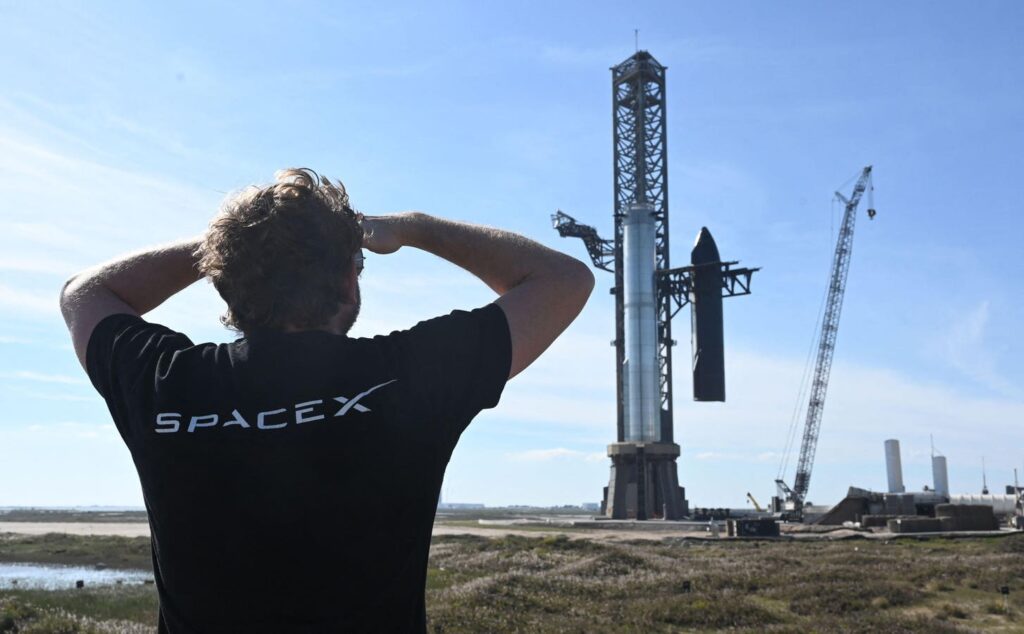With two-thirds of the satellites currently in low-Earth orbit, SpaceX has become the king of the heavens, overseeing a growing broadband internet empire on the ground. But when it comes to the nascent business of using satellites to connect to mobile phones in remote areas beyond the reach of telecom towers, SpaceX has been far more constrained. So far, it’s been working with a narrow band of T-Mobile’s cellular spectrum in the U.S., only able to relay text messages.
Billionaire Elon Musk’s company took a step to break out in a big way Monday, announcing the purchase of a long-coveted chunk of spectrum from EchoStar that’s perfect for beaming signals to mobile phones from space. The hefty price tag, $17 billion, makes it SpaceX’s largest acquisition by far. The company touted that the spectrum it’s buying will allow it to field new satellites that provide 20 times the throughput and full 5G phone service – complete with video calls from on top of any scenic mountain you want to climb.
But those promises come with a caveat: those new satellites appear to be designed to be launched by the giant rocket it’s developing, Starship. If Starship doesn’t work as promised, that would be a giant monkey wrench, said Caleb Henry, an analyst with Quilty Space. SpaceX’s direct-to-cell plans are “dependent on Starship,” he said.
Though its most recent test flight went well, breaking a streak of three straight that ended with spectacular explosions, questions still abound as to the soundness of Starship’s design and whether it can deliver the drastic reduction in launch costs Musk has promised.
The rocket is designed to carry 100 tons of payload to low-Earth orbit, more than four times as much as SpaceX’s workhorse Falcon 9. To take advantage of that, SpaceX has built a larger, more powerful next-generation broadband satellite that’s too large to be launched in meaningful numbers by Falcon 9. The company is most likely doing the same with the next version of its direct-to-cell satellites to provide better service, said Henry.
“When you want to close a link with a weak antenna in a phone, you have to make the satellite a lot more powerful,” he said.
SpaceX put 655 of its first generation of direct-to-cell satellites into orbit on Falcon 9, but it halted launches in June and is now waiting on Starship.
Musk is promising that the rocket’s huge payload capacity, plus making it fully reusable, will also allow SpaceX to radically decrease launch costs, allowing it to build out service at an affordable price to customers. Proving out reusability remains contingent on the rocket not blowing up on a regular basis. But SpaceX also needs to show that Starship can actually haul 100 tons to low-Earth orbit, said Henry. The latest version it’s tested is only designed to carry 35 tons.
The deal itself isn’t as big a lift for SpaceX, even though $17 billion may look like a big chunk of change for a company that Musk claims is headed for $15.5 billion in revenue this year. It could fetch $4 billion to $5 billion from leasing the spectrum for terrestrial use by cellular companies, said Philip Burnett, a telecom analyst at New Street Research. And the $8.5 billion in stock that’s part of the deal is essentially “free” given the enthusiasm of investors for the company. SpaceX is reportedly in the middle of raising capital at a $400 billion valuation, and it wouldn’t have problems tapping the debt markets to finance the deal, said Burnett.
Nonetheless, analysts were surprised by SpaceX’s willingness to pay out as much as it did given the uncertain prospects for making it back in the nascent direct-to-cell market. T-Mobile this summer launched service at an introductory price of $10 a month. Analysts guestimate the total opportunity initially could be a couple billion dollars. The big three cellular carriers could have put that spectrum to much more profitable use terrestrially, said Burnett.
“SpaceX had to apply a terrestrial wireless price effectively for spectrum that will be used in a project that might not generate the kind of returns that you see in wireless,” said Burnett.
For Musk, the motivation may be in driving EchoStar out of the market, and putting pressure on other competitors. EchoStar’s decision to sell most of its radiofrequency rights to AT&T and SpaceX came as it struggled with a crushing debt load. Worse, after complaints from SpaceX, the FCC launched a review that could have led to the revocation of its licenses to the spectrum for failing to use it.
But billionaire founder Charlie Ergen was still in a strong negotiating position with SpaceX, said Tim Farrar, an independent space and telecom analyst, because the spectrum it held is one of a kind. “There weren’t any other comparable options on the table at this point in time and potentially ever. So it was sort of take it or leave it,” he said.
Much of the 50 megahertz of radiofrequency bands that EchoStar is selling lie in a range of frequencies that were originally set aside for mobile satellite services because they’re the most efficient for space-to-ground transmissions.
Farrar believes the deal could push Apple to abandon its efforts to build out an in-house capability for direct-to-device internet with Globalstar; SpaceX wants to be its partner instead. With the addition of EchoStar’s prized spectrum, “I think there’s a significant possibility that Apple will change horses,” said Farrar.
But for that to happen, SpaceX still needs to harness the spectrum, and a big part of the equation is Starship. “For it to be as disruptive as SpaceX wants it to be, we need to see the performance improve,” said Henry.
Read the full article here

















